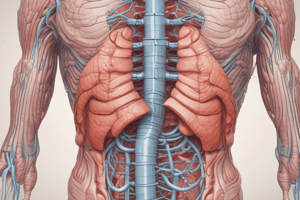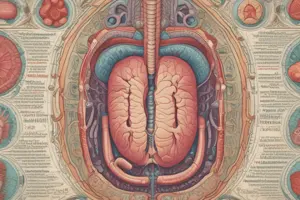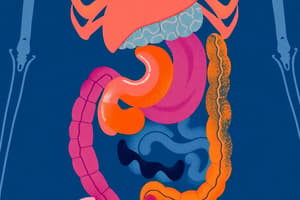Podcast
Questions and Answers
Which of the following organs is considered part of the gastrointestinal (GI) tract?
Which of the following organs is considered part of the gastrointestinal (GI) tract?
- Liver
- Salivary glands
- Pancreas
- Stomach (correct)
What is NOT a function of the digestive system?
What is NOT a function of the digestive system?
- Absorption
- Secretion
- Respiration (correct)
- Ingestion
Which layer of the GI tract wall is responsible for motility, especially peristalsis?
Which layer of the GI tract wall is responsible for motility, especially peristalsis?
- Serosa
- Muscularis (correct)
- Submucosa
- Mucosa
What structure extends from the soft palate and elevates during swallowing?
What structure extends from the soft palate and elevates during swallowing?
Which region of the oral cavity is located between the lips and the dental arch?
Which region of the oral cavity is located between the lips and the dental arch?
Which of the following accessory digestive organs produces bile?
Which of the following accessory digestive organs produces bile?
What is the correct order of the tunics (layers) of the GI tract from deep to superficial?
What is the correct order of the tunics (layers) of the GI tract from deep to superficial?
What type of digestion involves the mechanical and chemical breakdown of food?
What type of digestion involves the mechanical and chemical breakdown of food?
Which surface of the teeth is closest to the midline of the dental arch?
Which surface of the teeth is closest to the midline of the dental arch?
What is a distinguishing feature of canines compared to other permanent teeth?
What is a distinguishing feature of canines compared to other permanent teeth?
What is the total number of molars typically found in one quadrant of the mouth?
What is the total number of molars typically found in one quadrant of the mouth?
What role does the epiglottis play during swallowing?
What role does the epiglottis play during swallowing?
What is the primary function of the stomach in the digestive process?
What is the primary function of the stomach in the digestive process?
Which sphincter prevents regurgitation of materials from the stomach?
Which sphincter prevents regurgitation of materials from the stomach?
How many deciduous teeth typically erupt in a child's mouth during early development?
How many deciduous teeth typically erupt in a child's mouth during early development?
Which part of the esophagus is controlled voluntarily?
Which part of the esophagus is controlled voluntarily?
Which part of the esophagus is under voluntary control?
Which part of the esophagus is under voluntary control?
What term describes the rhythmic contraction that pushes food through the GI tract?
What term describes the rhythmic contraction that pushes food through the GI tract?
How does the composition of deciduous teeth differ from permanent teeth?
How does the composition of deciduous teeth differ from permanent teeth?
What is the length of the esophagus in an average adult?
What is the length of the esophagus in an average adult?
What structure is primarily responsible for the final mechanical digestion and mixing of food in the stomach?
What structure is primarily responsible for the final mechanical digestion and mixing of food in the stomach?
Which layer of the gastrointestinal tract is primarily responsible for nutrient absorption?
Which layer of the gastrointestinal tract is primarily responsible for nutrient absorption?
What is the function of the uvula in the digestive system?
What is the function of the uvula in the digestive system?
Where is the esophagus located relative to other body structures?
Where is the esophagus located relative to other body structures?
What is the primary composition of the tongue?
What is the primary composition of the tongue?
Which of the following is a function of saliva?
Which of the following is a function of saliva?
What percentage of total saliva is produced by the submandibular salivary glands?
What percentage of total saliva is produced by the submandibular salivary glands?
Where are the parotid salivary glands located?
Where are the parotid salivary glands located?
Which structure is involved in the manipulation and mixing of ingested materials?
Which structure is involved in the manipulation and mixing of ingested materials?
What is a characteristic of sublingual salivary glands?
What is a characteristic of sublingual salivary glands?
Which part of the teeth is primarily composed of enamel?
Which part of the teeth is primarily composed of enamel?
Which of the following structures is not associated with the oral cavity?
Which of the following structures is not associated with the oral cavity?
Flashcards
What are the two categories of digestive organs?
What are the two categories of digestive organs?
The digestive system includes the gastrointestinal (GI) tract and accessory digestive organs. The GI tract is a continuous tube responsible for digestion and absorption, while accessory organs support the digestive process.
What are the components of the GI tract?
What are the components of the GI tract?
The GI tract includes the mouth, pharynx, esophagus, stomach, small intestine, large intestine, and anal canal. It's a continuous pathway for food to travel.
What are the accessory digestive organs?
What are the accessory digestive organs?
Accessory digestive organs help with digestion but aren't part of the GI tract. They include teeth, tongue, salivary glands, liver, gallbladder, and pancreas.
What is peristalsis?
What is peristalsis?
Signup and view all the flashcards
What are the four tunics of the GI tract?
What are the four tunics of the GI tract?
Signup and view all the flashcards
What are the two regions of the oral cavity?
What are the two regions of the oral cavity?
Signup and view all the flashcards
What is the palate?
What is the palate?
Signup and view all the flashcards
What does the uvula do?
What does the uvula do?
Signup and view all the flashcards
What are the surfaces of a tooth?
What are the surfaces of a tooth?
Signup and view all the flashcards
Deciduous teeth
Deciduous teeth
Signup and view all the flashcards
Permanent teeth
Permanent teeth
Signup and view all the flashcards
Incisors
Incisors
Signup and view all the flashcards
Canines
Canines
Signup and view all the flashcards
Premolars
Premolars
Signup and view all the flashcards
Molars
Molars
Signup and view all the flashcards
Wisdom tooth
Wisdom tooth
Signup and view all the flashcards
What's the primary function of the tongue?
What's the primary function of the tongue?
Signup and view all the flashcards
Lingual Frenulum
Lingual Frenulum
Signup and view all the flashcards
Papillae
Papillae
Signup and view all the flashcards
What's the function of saliva?
What's the function of saliva?
Signup and view all the flashcards
Parotid Glands
Parotid Glands
Signup and view all the flashcards
Submandibular Glands
Submandibular Glands
Signup and view all the flashcards
Sublingual Glands
Sublingual Glands
Signup and view all the flashcards
What are the parts of a tooth?
What are the parts of a tooth?
Signup and view all the flashcards
What is the function of the stomach?
What is the function of the stomach?
Signup and view all the flashcards
What is the difference between the GI tract and accessory organs?
What is the difference between the GI tract and accessory organs?
Signup and view all the flashcards
What is the location and function of the visceral peritoneum?
What is the location and function of the visceral peritoneum?
Signup and view all the flashcards
What is the soft palate?
What is the soft palate?
Signup and view all the flashcards
Where is the uvula located?
Where is the uvula located?
Signup and view all the flashcards
What is the function of the parotid gland?
What is the function of the parotid gland?
Signup and view all the flashcards
Study Notes
Digestive System Overview
- The digestive system is categorized into two main parts: the gastrointestinal (GI) tract and accessory digestive organs.
- The GI tract is a continuous tube, encompassing several key structures: oral cavity, pharynx, esophagus, stomach, small intestine, large intestine, and anal canal.
- Accessory organs, like teeth, tongue, salivary glands, liver, gallbladder, and pancreas, support the digestive process but are not part of the GI tract.
Oral Cavity
- The oral cavity has two main regions: vestibule and oral cavity proper.
- The hard palate, the anterior portion of the palate, consists of bone, while the soft palate, the posterior portion, is muscular.
- The uvula is a fleshy extension of the soft palate, involved in swallowing.
- Tongue, with papillae, manipulates food and aids in swallowing.
- Teeth and salivary glands are crucial for initial digestion.
Salivary Glands
- Saliva, produced by salivary glands, moistens food, cleanses structures, and facilitates taste recognition.
- Major salivary glands include parotid, submandibular, and sublingual glands.
- Parotid glands account for about 25-30% of saliva, situated near the ears, and their duct opens near the upper 2nd molars.
- Submandibular glands constitute 60-70% of saliva, located under the mandible, with the duct opening near the frenulum.
- Sublingual glands generate approximately 3-5% of saliva, situated below the tongue, and their ducts open under the tongue.
Teeth
- The teeth (collectively called dentition) have distinct surfaces (mesial, distal, buccal, labial, lingual, occlusal).
- Two sets of teeth develop: deciduous (milk teeth) and permanent teeth.
- Deciduous teeth typically develop between 6-30 months of age, and permanent teeth replace them.
- Tooth types include incisors, canines, premolars, and molars, adapted for various functions like slicing, puncturing, crushing, and grinding.
Pharynx
- The pharynx is a shared passageway for both the respiratory and digestive systems.
- The oropharynx and laryngopharynx are parts of the pharynx involved in swallowing. The epiglottis, a flap of cartilage, helps direct food into the esophagus during swallowing, preventing it from entering the trachea.
Esophagus
- The esophagus, about 10 inches long, carries food from the pharynx to the stomach.
- It transitions from skeletal muscle at the superior end (voluntary control) to smooth muscle at the inferior end (involuntary contractions), a critical feature during swallowing.
- Sphincters, specifically the superior and inferior esophageal sphincters, regulate the passage of food. The superior esophageal sphincter prevents air from entering the esophagus, and the inferior esophageal sphincter prevents reflux from the stomach back to the esophagus.
Stomach
- The stomach is located in the upper left quadrant of the abdominal cavity.
- It primarily performs mechanical and chemical digestion on ingested materials, transforming the bolus into chyme.
Learning Outcomes
This is a set of suggested learning objectives, representing the key learning points of the digestive system. Note these were presented as potential learning goals, not necessarily as definitive summaries.
Studying That Suits You
Use AI to generate personalized quizzes and flashcards to suit your learning preferences.




